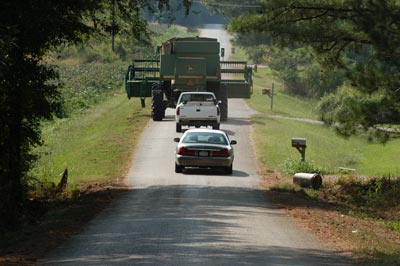Farm-City Week: Alabama Loses Ground In The Ol’ Sprawl Game

Call it what you want — urban sprawl, smart growth or just plain ol’ progress. Whatever you call it, don’t try convincing Limestone County row crop farmer Chad Henderson that it’s a myth or a good thing. He knows better.The 300 acres he planted in grain this year will be sprouting a different crop next season — a new subdivision — as the current housing boom swallows up even more of the Tennessee Valley farmland he had leased.”The only thing they’re planting around here is houses,” Henderson sighed recently. “I’m losing ground fast. That’s my biggest problem — subdivisions. And a lot of these people come in and build a subdivision and expect you to change your life.”It’s a story you’ll hear often on the farms and in the pastures and fields all across Alabama as the nation prepares to observe Farm-City Week Nov. 18-24. As more and more city dwellers seek refuge in the greener pastures of suburbia and more and more farmland gives way to concrete, asphalt and unfathomable real estate prices, the tension between those who tend the soil and those who pave it grows as well.”As farmer numbers decline and more city people move out to the country, it becomes more and more important that these two segments of society gain a better understanding of each other,” said Alabama Farmers Federation Administrator J. Paul Till, who chairs the state Farm-City Committee and serves as vice chair on the national board of the Farm-City Council. “That is what Farm-City is all about,” said Till. “The Farm-City program facilitates communication which in turn improves understanding and relationships between rural and urban people.”It’s an honorable goal, but certainly not a new one. It speaks volumes that this marks the 50th year that Farm-City Week has sought to foster better relations between the farmers and their unending stream of new neighbors from the city.”It’s not a trend — it’s a reality,” said John Dunkelberger, who’s retired from Auburn University’s Department of Agricultural Economics and Rural Sociology. “It’s been going on forever. Look at the pilgrims … or (Henry David) Thoreau’s ‘Walden’s Pond.’ … He was responding to the things that are changing, that the urban ways are creeping into that bucolic existence, and his pond isn’t going to be there much longer. I think that’s typical of any place. If you are going to have more people, those people are going to have to live someplace, and they are going to spread out.”It’s too early to tell just how much more ground will be lost before the housing bubble bursts. But, at last official count, Alabama had lost 612,990 acres of farmland — almost a quarter-acre per minute — between 1997 and 2002. That’s according to the 2002 U.S. Agricultural Census, which defines a farm as any establishment from which $1,000 or more of agricultural products were sold or would normally be sold during the year.Limestone County led the state in farmland lost during that five-year span at 44,183 acres — more than an acre every single hour. In all, 45 of Alabama’s 67 counties lost farmland. Barbour County reversed that trend and actually added 23,812 acres to lead the state in farmland gained. Whether it has been able to sustain that reversal of fortune since 2002 remains to be seen.But it’s more than just lost land — it’s a lost lifestyle. Jessie Hobbs, who farms 3,000 acres of row crops in Limestone County and Giles County, Tenn., says all too often this latest generation of newcomers has never been exposed to farm life and country living. “You’d be amazed at how many people in Elkmont came from Huntsville,” he said. “Urban sprawl is hitting everyone due to the simple fact that the person making $150,000 in Huntsville wants to walk out in the back yard barefooted … and not have someone looking over the fence or pointing. But then they get out here and it’s like, ‘City water?!’ … ‘You don’t have sewer? A septic tank!’ …or ‘This road isn’t as nice as I-65.'”Over in Madison County, Henderson says one-on-one education is about all a farmer can do to build a relationship with rural newcomers who suddenly realize that country living may also bring with it different sights and sounds.”You try to educate them the best you can,” said Henderson, who says one of his new neighbors constantly complains about the dust kicked up by his tractors or cotton pickers. “You have to let ’em get mad, let ’em talk, let ’em blow up. It’s a matter of patience.”Blount County poultry farmer Dennis Maze feels much the same. “People in urban areas don’t realize where food comes from,” he said. “They go to Wal-Mart and Winn-Dixie, and they don’t realize it’s being produced by a few people. They’re too many generations removed from the farm … Everybody needs to co-exist and work together because, without us, the urban folks are not going to eat. We really need to get our message out.”Dunkelberger, however, reminds farmers that communication is a two-way street. “It’s trying to make both sides appreciate the dilemma and perspective on both sides,” he said. “If you are in agriculture, you think you are going to get people in the city to appreciate and love us. But you’ve got to get a good symbiosis between the two. Rather than being enemies, we’ve got to be cooperatives.”
